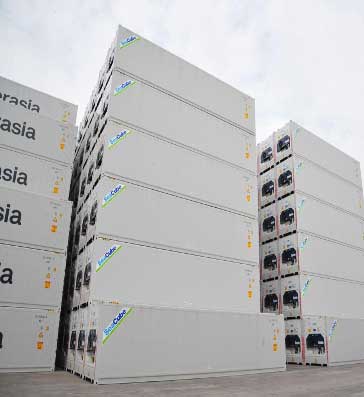Refrigerated container market continues to grow as movement of temp-controlled cargo proliferates worldwide.
By Greg Tuthill, CCO, SeaCube Containers
Stakeholders throughout the supply chain understand 2023 will not be like any other year—and this is especially true for the cold chain, both in terms of challenges and opportunities. Offering reliability and predictability, the reefer market continues to grow and has proven to be more resilient in the face of supply chain disruption as the movement of temperature-controlled cargo continues to be prioritized.
While a fluid cold chain is critical to feeding the world’s population, cold chain fluidity does not “just happen” – it relies on investment and innovation. Ocean carriers looking to optimize their refrigerated equipment investment need a strategic roadmap that addresses the ongoing economic and geopolitical challenges, food supply shortages, food waste, refrigerated equipment capacity – all while working to reach sustainability goals.
Greg Tuthill, Chief Commercial Officer (CCO) of SeaCube Containers, a global leader in intermodal refrigerated equipment leasing, looks closely at the top four cold chain growth drivers.

Nearly 40 percent of food produced in the world is lost, with 7 to 15 percent spoiling during transport. Lost containers contribute to the problem; however, a more significant and preventable problem is related to the container temperature or poorly packed containers. This is especially true for fruits and vegetables, which are especially vulnerable because they are loaded onto containers in corrugated boxes, which offer no protection from spoilage.
Food waste has been a persistent issue, and it will prove to be an even bigger problem in 2023 as experts predict food supply shortages will continue to get worse throughout the year. This elevates the need to take action to reduce food waste by investing in technology that will protect food during the transport journey.
While today’s refrigerated equipment provides superior cold storage, arming reefer fleets with telematics technology allows for greater collaboration, increased transparency, and real-time data, which provides accurate information on the exact location of the container, which is necessary for proper planning. Telematics also provide insight into the temperature, humidity, and air flow inside the container, which ensures the quality of the cargo is protected and waste is reduced.

As the world’s population continues to grow, so does the need to move food safely and swiftly throughout the world. The transport journey for this temperature-controlled food can be long and there is the risk of contamination and damage every step of the way. This elevates the need for state-of-the-art refrigerated equipment that includes telematics to ensure the cargo is handled properly throughout the entire journey.
The reefer market is expected to grow on average five percent year over year through 2025 while breakbulk containers demand will drop 15 percent. The movement of fruits and vegetables will be the key driver in the temperature-controlled cargo market as consumers expect “off season” perishables to be readily available all year long.
In 2018, the government-imposed regulations that compel the shipping industry to reduce carbon emissions by half by mid-century. With aggressive sustainability goals, the shipping industry is looking to make changes throughout the supply chain, and there are significant opportunities within the reefer sector. Innovation and open-mindedness are the keys to reaching decarbonization goals.
Carbon Dioxide (CO2) as a refrigerant is used more because of its zero depleting characteristics and its global warming potential of one. CO2 as a natural refrigerant is one of the most environmentally sustainable alternatives for refrigerated marine transport. Other considerations for reducing greenhouse gas emissions include variable speed drives for compressors and two-speed evaporator fans, which offer energy efficiency and can elevate even the most optimal operation linked to an energy-efficient fleet. Acting now to limit the damage from climate change is often smarter—and costs less in the long run—than acting later.
Technological advancements, digitalization and the digital transformation of businesses will be a growth driver not just for the reefer market, but for the entire supply chain.
Technology will be used to map the entire end-to-end supply chain more accurately– from the direct supplier to the second-tier supplier and beyond. “Smart” containers are equipped with telematics that provide real-time tracking and monitoring. This enables customers to plan their inventory and production accordingly and operators to increase turn-time and improve equipment availability. These containers provide real-time visibility of its location and contents. Telematics also provide preventive measures using algorithms that recognize failures before they happen, notification of erratic driver behavior, potential theft, and safety issues.
The use of telematics in the maritime shipping industry is expected to explode in the coming years. According to data from Allied Market Research, telematics investment is expected to grow in maritime shipping by a CAGR of 21.3% by 2026. This stat is a strong statement about the supply chain industry’s commitment to investing in technology to address critical cold chain issues.

The reefer market represents the most resilient sector within the shipping industry. Even during times of economic and geopolitical uncertainty, food must be transported in equipment that is up to the task. With the growing population and potential food supply shortages, the industry has a responsibility to take all necessary steps to mitigate food waste — and technology is the key to delivering on that promise.
The pressure to reach very aggressive sustainability goals has the industry looking for a silver bullet and while that may not exist, the current carbon emission-reducing solutions connected to reefers present an opportunity to make a significant impact and the potential solutions on the horizon are very exciting.

About the Author
As SeaCube’s Chief Commercial Officer, Gregory Tuthill leads the global sales, marketing, and trade teams. He brings over 30 years of industry experience to this position. Prior to SeaCube, Mr. Tuthill was Senior Vice President and Chief Operating Officer for CMA-CGM. He also held various positions including Head of Operations at APL and several executive positions during his 16 years at NYK Line. Mr. Tuthill served in the United States Naval Reserve as a Commissioned Officer and holds a US Coast Guard Third Mates License. He has obtained a Bachelor’s Degree in Computer Science from the State University Maritime College at Fort Schuyler, NY and earned a Master’s Degree in Financial Economics from Fairleigh Dickinson University. He also holds a certificate in Financial Analysis from New York University.
In this episode, I sat down with Beejan Giga, Director | Partner and Caleb Emerson, Senior Results Manager at Carpedia International. We discussed the insights behind their recent Industry Today article, “Thinking Three Moves Ahead” and together we explored how manufacturers can plan more strategically, align with their suppliers, and build the operational discipline needed to support intentional, sustainable growth. It was a conversation packed with practical perspectives on navigating a fast-changing industry landscape.